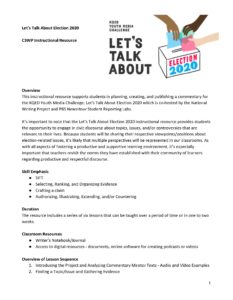Creating Multimedia Persuasive Commentaries: Adaptable Resources from Let’s Talk About Election 2020
How can we engage students in researching and crafting arguments that matter to them and their communities? How can we support them in creating authentic products and going public with them? Providing students with opportunities to identify and explore issues that matter to them builds their identities as writers and members of their local, national, and global communities.
NWP’s Writing Our Future projects with longtime partner KQED have been built around opportunities for publication by young writers. These materials contained here were originally created to support educators working on KQED’s campaign Let’s Talk About Election 2020. On the attached PDF, you can find some background information on the campaign along with some planning points for teachers. The webinar recordings below include discussion and modeling of strategies to support students in selecting topics based on issues that matter to them, finding reliable and credible evidence, planning and drafting a script, and publishing an audio or video commentary.
The approaches discussed in the recordings focus on a type of argumentation that invites students to explore multiple perspectives on an issue and to join the conversation using evidence they gather from sources and their own lives. The overall goal of the resource is to explore concrete ideas and strategies for building students’ skills in civic literacy and multimodal composing. Although some parts of the resources focus on specifics connected to Let’s Talk About Election 2020, such as how to sign up, the lesson sequences and activities are easily adapted.
High School Breakout
In the high school breakout, participants engage in three activities that focus on supporting students in reading and studying mentor texts of digital commentaries, finding a topic that matters to them, and using Mike Caulfield’s SIFT process to evaluate the reliability and credibility of sources and evidence. These activities come from a longer instructional sequence that takes students through the entire process of creating an audio or video persuasive commentary.
Middle School Breakout
In the middle school breakout, participants hear from 6th-, 7th-, and 8th-grade teachers who have supported students in creating audio or visual commentaries about issues that matter to them. They share their takeaways from the process, how they communicated with parents, and the instructional sequences they used to support students in creating their commentaries. They also share samples of student work, including some student audio and visual commentaries.
Upper-Elementary Breakout
In the upper-elementary breakout participants explore ideas and strategies for supporting elementary students in this type of civic engagement. They also discuss possibilities for supporting younger students in using digital tools and going public with their commentaries.


